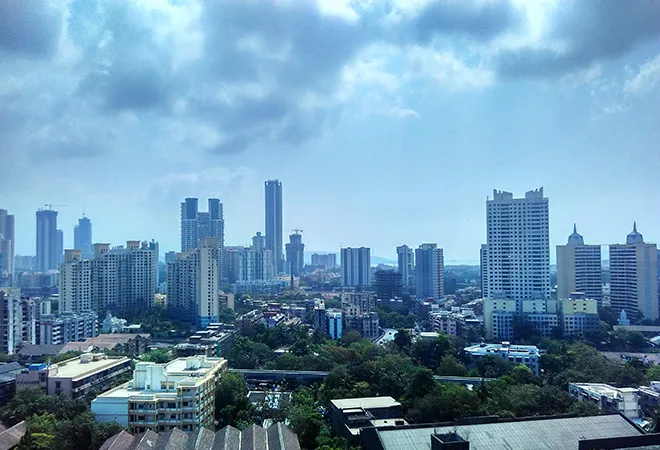-
CENTRES
Progammes & Centres
Location
Unless India takes up urban planning with the seriousness it deserves, the future of some of the mega projects of the incumbent government such as the Smart Cities Mission, Swachh Bharat Mission, HRIDAY for heritage cities, Housing for All by 2022 and AMRUT are bound to suffer from the same consequences.
 In the Economist Intelligence Unit’s (EIU) Global Liveability Index released on 4 September 2019, two of India’s biggest cities — New Delhi and Mumbai — slipped several notches. The global index, which ranks 140 cities across the world on their overall quality of life, downgraded India’s political capital New Delhi by six notches to 118th, while the commercial capital Mumbai followed next at 119, registering a fall of two places.
The index accesses which cities around the world present the best or the worst living conditions by assigning each city with a rating of “relative comfort” for over 30 qualitative and quantitative factors across five basic categories. The categories being: i)stability, ii) healthcare, iii)culture and environment, iv)education and v)infrastructure. While stability and culture and environment in a city are given a weightage of 25 percent each, healthcare and infrastructure are each given 20 percent, and education getting the remaining 10 percent weightage. Each factor in a city is rated as acceptable, tolerable, uncomfortable, undesirable or intolerable. The scores are then compiled and weighted to provide a score of one to 100, where one is intolerable and 100 is ideal. Points of reference for the score of each city are provided relative to New York, to prepare the liveability index.
In the Economist Intelligence Unit’s (EIU) Global Liveability Index released on 4 September 2019, two of India’s biggest cities — New Delhi and Mumbai — slipped several notches. The global index, which ranks 140 cities across the world on their overall quality of life, downgraded India’s political capital New Delhi by six notches to 118th, while the commercial capital Mumbai followed next at 119, registering a fall of two places.
The index accesses which cities around the world present the best or the worst living conditions by assigning each city with a rating of “relative comfort” for over 30 qualitative and quantitative factors across five basic categories. The categories being: i)stability, ii) healthcare, iii)culture and environment, iv)education and v)infrastructure. While stability and culture and environment in a city are given a weightage of 25 percent each, healthcare and infrastructure are each given 20 percent, and education getting the remaining 10 percent weightage. Each factor in a city is rated as acceptable, tolerable, uncomfortable, undesirable or intolerable. The scores are then compiled and weighted to provide a score of one to 100, where one is intolerable and 100 is ideal. Points of reference for the score of each city are provided relative to New York, to prepare the liveability index.
Bracketed in the bottom quartile with the usual suspect cities from Africa, West Asia, South Asia and South America, both New Delhi and Mumbai as India’s leading megapolises face numerous challenges in providing their beleaguered citizens a better quality of life. If this is the scenario with two of our most vibrant global cities, the challenges for the rest of urban — and fast urbanising — India indeed seem daunting. Such poor global recognition poses a few difficult questions. Will India, slated to have half of its projected population of 1.50 billion by 2030 residing in urban areas, only end up pushing more and more people into increasingly unliveable slum-like environs? Will cities, as engines of economic growth, continue to drive India’s march into the 21st century or will they turn out to be our biggest impediments? Are these questions really a cause of worry for the government? Sadly, the answer is in the negative, especially considering that Mumbai, a city that is deservedly placed at a poor 119th in the global liveability index, is considered by the Union Ministry of Housing and Urban Affairs (MoHUA) to be one of India’s top-three cities providing the ideal “ease of living” conditions to its citizens. In early August, MoHUA released India’s first Ease of Living Index featuring 111 cities. Unlike the five specific categories encompassing a diverse set of quantitative and qualitative factors in the EIU index, MoHUA measured the performances of these cities on 78 physical, institutional, social and economic indicators. These indicators were spread across 15 parameters: governance, identity and culture, education, health, safety and security, economy, affordable housing, land use planning, public open spaces, transportation and mobility, assured water supply, waste-water management, solid waste management, power, and quality of environment. Significantly, despite the well-known daily struggle that 23 million people in Mumbai have to face, the city was ranked as the third-easiest city to live in. Perhaps the government must have considered positives such as the general sense of safety and uninterrupted power supply — a rarity in the rest of the urban centres in the country — to rate Mumbai so highly. On the contrary, Delhi, despite its acclaimed people-friendly mass transit infrastructure was rated at a relatively poor 65th position, far below Chennai (14), Ahmedabad (23) and Hyderabad (27). Looking at the disconcertingly low ranks given to both Delhi and Mumbai in the Global Liveability Index, the methodology adopted by the MoHUA is indeed worth examination. Otherwise, instead of giving any concrete direction to government efforts towards sustainable and equitable urban development, such national rankings, far from providing ‘ease of living’, will only create more difficulties for the India’s urban population.Will cities, as engines of economic growth, continue to drive India’s march into the 21st century or will they turn out to be our biggest impediments?
Notwithstanding such indices or the methodologies adopted for their preparation, it is true that the governance of Indian cities is besotted with basic and deeply entrenched flaws. So much so, that no particular city stands a chance of coming anywhere close to the global benchmarks in most of the above-mentioned parameters. Failed attempts made by successive governments in the past provide ample proof of the urban mess that India has created for itself. A case in point is the Jawaharlal Nehru National Urban Renewal Mission (JNNURM), implemented across India by the UPA I government in 2005. Based on broad reforms that were to be undertaken by local bodies in provision of infrastructure and civic services, the MoHUA committed INR 662.53 billion to states for upgrading urban infrastructure — including for the poorest of the poor. The payment of the grants was contingent on local bodies undertaking mandatory reforms and establishing benchmarks in the critical sectors of i) urban renewal, i.e. redevelopment of inner (old) city areas including widening of narrow streets, shifting of industrial and commercial establishments from non-conforming (inner city) areas to conforming (outer city) areas to reduce congestion, replacement of old and worn out pipes by new and higher capacity ones, renewal of the sewerage, drainage, and solid waste disposal system etc.; ii) water supply and sanitation; iii) sewerage and solid waste management; iv) construction and improvement of drains and storm water drains; v) transportation including roads, highways, expressways, mass rapid transport services, and metro projects; vi) provision of designated parking lots and spaces on PPP basis; vii) development of heritage areas; viii) prevention and rehabilitation of soil erosion and landslide and ix) preservation of water bodies.Based on broad reforms that were to be undertaken by local bodies in provision of infrastructure and civic services, the MoHUA committed INR 662.53 billion to states for upgrading urban infrastructure.
The views expressed above belong to the author(s). ORF research and analyses now available on Telegram! Click here to access our curated content — blogs, longforms and interviews.

Dhaval is Senior Fellow and Vice President at Observer Research Foundation, Mumbai. His spectrum of work covers diverse topics ranging from urban renewal to international ...
Read More +